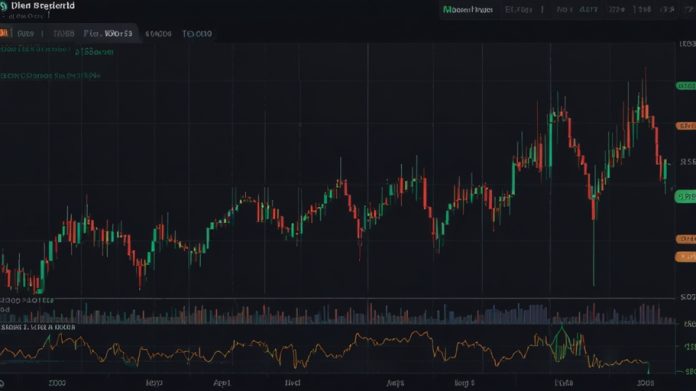The stock market’s recent pullback has left many investors questioning whether the rally that dominated the beginning of 2025 is starting to lose steam. As U.S. futures show a mixed performance and sentiment remains cautious, the mood is further clouded by the recent downgrade of the U.S. debt outlook by Moody’s and warnings from prominent figures like Jamie Dimon, who cautioned that earnings may soon take a hit. As markets grapple with these headwinds, the critical question for investors is: Should we be worried, or is this just a temporary setback in an otherwise bullish year?
The Current Market Environment
As of May 20, 2025, stock futures reflect a subdued market environment. The S&P 500 futures are down slightly by 0.26%, Nasdaq 100 futures have dropped by 0.44%, and Dow Jones futures are marginally lower by 0.10%. While European markets show a more positive outlook, buoyed by easing geopolitical tensions, the U.S. market sentiment remains relatively cautious. This is primarily due to a combination of the Moody’s downgrade of the U.S. credit outlook and ongoing concerns over fiscal stability in Washington. The downgrade has reignited fears about the long-term sustainability of U.S. fiscal policy, especially as rising interest payments and political gridlock continue to weigh on sentiment.
U.S. Debt Downgrade: A Wake-Up Call?
Moody’s decision to downgrade the U.S. credit outlook is a significant development that cannot be ignored. This move reflects concerns over the country’s rising debt levels and the political challenges surrounding fiscal policy. While Treasury yields have remained stable for now, investors are increasingly wary of the long-term implications of rising debt and the potential for political gridlock to delay necessary fiscal reforms. The U.S. has been operating with a high level of debt for years, but the downgrade serves as a stark reminder that financial markets are closely watching the sustainability of these policies. The downgrade could lead to higher borrowing costs, which in turn could exacerbate the fiscal situation and dampen economic growth prospects.
This issue, combined with President Trump’s recent comments on trade and deficit control, has created a complex backdrop for asset allocation. While Trump’s announcement of a 90-day tariff truce with China and the EU has eased immediate trade tensions, the underlying uncertainty about the long-term resolution of these disputes continues to simmer, adding to investor unease.
Jamie Dimon’s Warning: Earnings Are at Risk
Adding to the uncertainty, Jamie Dimon, the CEO of JPMorgan Chase, recently warned that earnings are likely to face significant pressure in the near future. Dimon’s comments were pointed, suggesting that while the market may have been optimistic about the earnings potential of major firms, the reality may be different. He highlighted the fact that many companies, especially those heavily exposed to global supply chains and rising costs, could soon report disappointing earnings.
This warning comes on the back of an already choppy earnings season, where even the tech-heavy Nasdaq—which has seen a sharp rally in recent months—began to show signs of weakness. The “Magnificent Seven”—Apple, Microsoft, Nvidia, Alphabet, Amazon, Meta, and Tesla—have been leading the rally, but profit-taking has begun, particularly as valuations become stretched. Several of these stocks, like Tesla and Apple, have already shown signs of fatigue, trading well below recent highs. The pullback from these mega-caps has had a noticeable impact on the broader S&P 500, exacerbating the market’s current uncertainty.
The Tech Sector and Rotation Pressure
The tech sector, particularly the Nasdaq, appears particularly vulnerable to further rotations. After months of sharp outperformance, investors are now starting to question whether the high valuations of some of the leading companies are justified, especially given the rising input costs and the potential for softer global demand. This is particularly relevant for the AI-exposed firms, which have enjoyed extraordinary valuations over the past year. As these stocks start to pull back, it could trigger a broader market correction, as the concentration in a few mega-caps continues to affect overall market breadth.
Should Investors Be Worried?
Given the convergence of factors—Moody’s downgrade, Dimon’s warning, geopolitical tensions, and a potential earnings slowdown—the current market pullback is a cause for caution. While there are still many reasons to be optimistic about the long-term prospects of the market, investors should be aware of the risks that are currently in play. The market’s pullback could be a healthy consolidation phase, especially after the strong rally seen earlier this year. However, it’s also possible that the market is facing more fundamental challenges, with rising costs, geopolitical risks, and fiscal instability at the forefront.
For now, the market appears to be in a “wait-and-see” mode, with investors holding back on making big bets until there is more clarity on fiscal policy, corporate earnings, and global trade. The lack of fresh economic data, combined with rising geopolitical tensions, means that the market could remain rangebound in the near term. While some sectors—like tech and AI—remain attractive, profit-taking and rotation out of overvalued stocks may be a necessary adjustment before any sustained upward movement can occur.
Conclusion: A Time for Caution, Not Panic
In conclusion, the current pullback in the market, fueled by concerns over U.S. fiscal stability, earnings pressures, and geopolitical uncertainties, is a sign that investors should proceed with caution. However, it is not necessarily a signal of an impending crash. Markets are in a period of transition, where key sectors are recalibrating after a strong rally. Investors should be prepared for more volatility, especially as earnings season progresses and new economic data comes in. While the downgrade and Dimon’s warning serve as important reminders of the challenges ahead, they also provide an opportunity for investors to reassess their portfolios and be more selective in their allocations.



 Bitcoin
Bitcoin  Ethereum
Ethereum  Tether
Tether  XRP
XRP  USDC
USDC  Wrapped SOL
Wrapped SOL  Lido Staked Ether
Lido Staked Ether  TRON
TRON  Cardano
Cardano  Avalanche
Avalanche  Toncoin
Toncoin